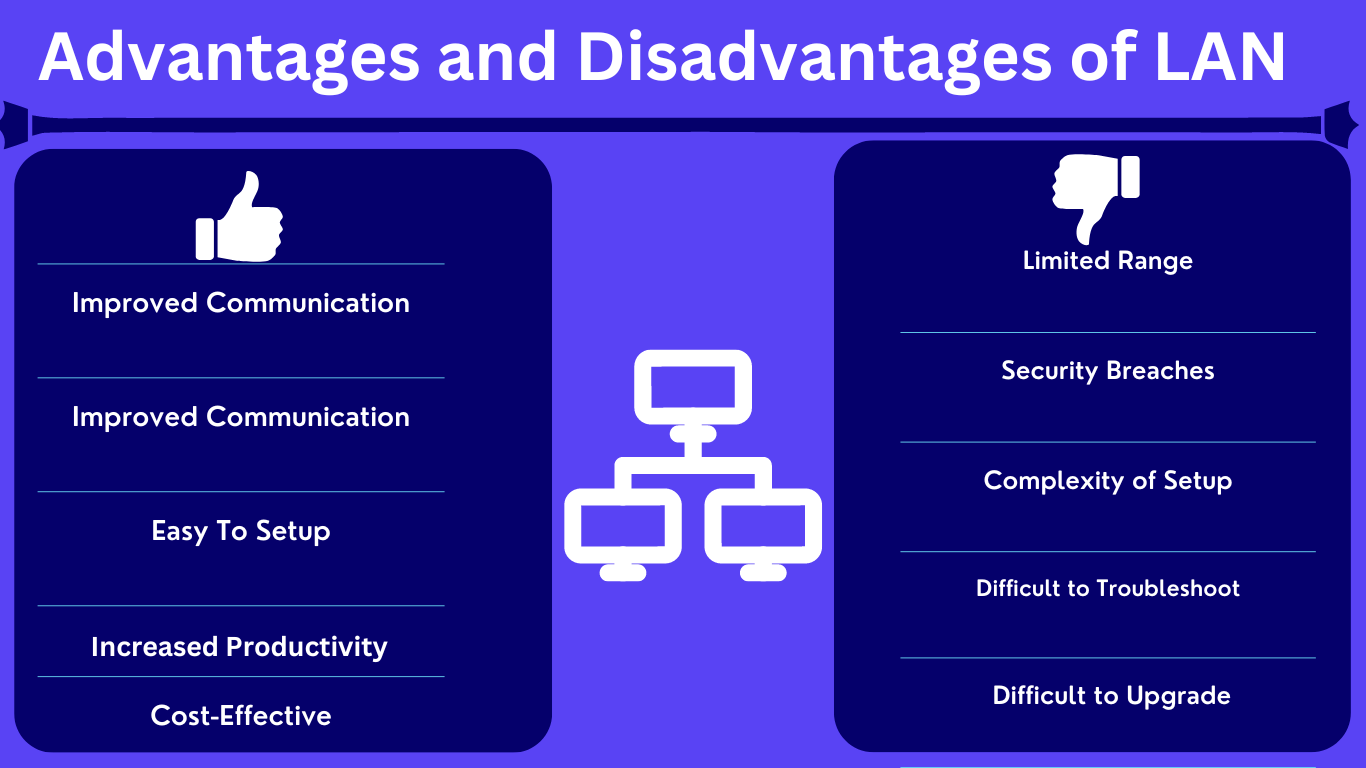Advantages and Disadvantages of LAN

Local Area Networks (LANs) offer several advantages and disadvantages, depending on the specific needs and requirements of users and organizations. Here are some of the key advantages and disadvantages of LANs:
Advantages of LANs:
Resource Sharing: LANs facilitate resource sharing among connected devices, allowing users to share files, printers, internet connections, and other peripherals. This promotes collaboration, increases efficiency, and reduces the need for duplicate resources.
Data Transfer Speed: LANs typically provide high-speed data transfer rates, enabling fast communication and data exchange between devices. This is essential for supporting bandwidth-intensive applications such as video streaming, file transfers, and real-time communication.
Centralized Management: LANs allow for centralized management of network resources and configurations. Network administrators can monitor and control network traffic, security settings, and user access rights from a central location, simplifying network management and administration.
Cost-Effectiveness: LANs can be cost-effective compared to wide-area networks (WANs) for connecting devices within a limited geographical area. They require less infrastructure, have lower operating costs, and can be deployed and maintained more affordably, making them ideal for small to medium-sized businesses and organizations.
Improved Communication: LANs facilitate communication and collaboration among users within the same physical location. Users can easily exchange messages, share files, and collaborate on projects using networked applications and services, enhancing productivity and teamwork.
Flexibility and Scalability: LANs are flexible and scalable, allowing organizations to easily add or remove devices, expand network capacity, and adapt to changing needs and growth. New devices can be connected to the LAN with minimal disruption, and network infrastructure can be upgraded or expanded as needed.
Disadvantages of LANs:
Limited Coverage: LANs have a limited coverage area, typically confined to a single building or group of buildings. This can restrict connectivity for users who need to access network resources from remote locations or outside the LAN's coverage area.
Security Concerns: LANs can be vulnerable to security threats such as unauthorized access, data breaches, and malware attacks. Without proper security measures in place, sensitive data and network resources may be at risk of compromise, leading to potential privacy violations and financial losses.
Dependency on Infrastructure: LANs rely on network infrastructure such as cables, switches, routers, and servers to function properly. Any issues or failures in the infrastructure can disrupt network connectivity and impact users' ability to access resources, leading to downtime and productivity losses.
Network Congestion: LANs may experience network congestion during peak usage periods, especially in environments with a high number of connected devices or bandwidth-intensive applications. This can result in slowdowns, latency issues, and degraded performance for users, affecting their productivity and user experience.
Complexity: LANs can be complex to design, deploy, and manage, especially in large or distributed environments. Configuring network settings, troubleshooting connectivity issues, and ensuring compatibility among different devices and technologies can require specialized knowledge and expertise.
Interference and Compatibility Issues: Wireless LANs (Wi-Fi) may be susceptible to interference from other electronic devices, physical obstacles, or environmental factors. Additionally, compatibility issues between different devices, operating systems, and network protocols can arise, leading to connectivity problems and usability issues.
Overall, while LANs offer numerous benefits in terms of resource sharing, communication, and efficiency, they also present challenges such as security concerns, network congestion, and complexity. Organizations must carefully assess their needs and implement appropriate measures to maximize the advantages of LANs while mitigating potential drawbacks.
Thank you,
